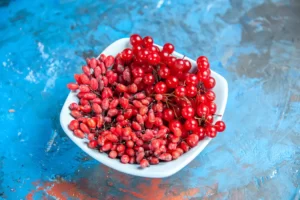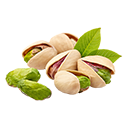



Barberry
Barberry is a large genus of deciduous and evergreen shrubs (Berberis Vulgaris), found throughout temperate and subtropical regions of the world. Barberry is native to the temperate and subtropical regions of Europe, Asia, Africa, North America, and South America. Barberry shrub is 1 to 5 meters long with red, brown, or yellow wood. The leaves are oval and the fruit is oval red and sour taste. Iran is the largest producer of barberry in the world and has 95% of the world’s barberry production. In Iran, barberry is a unique species and mostly cultivated in South Khorasan. According to evidence the cultivation of seedless Red barberry in South Khorasan goes back to two hundred years ago. The main season for Barberry cultivation is the end of spring and early summer.
Types
we have two types of barberry in our company: Puffy and Shiny red; and we supply the below grades of each Barberry: High Clean and AAA.
Puffy Barberry (Pofaki)
This type of Barberry which is also known as Barberry Pofaki is most popular for its color and form. Since it is dried on the tree it gets Puffy. Their Moisture level of Barberry Puffy is between 12-14%. Their rate of moisture affects their perceivable levels. They are mainly from the northeastern provinces of Iran to be exact North Khorasan and Razavi Khorasan in cities such as Birjand.
Shiny red Barberry (Dane Anari)
This type of Barberry which is also known as Barberry Dane Anari is most popular for its competitive price. Their Moisture level of Barberry Shiny Red is between 15-17%. Their rate of moisture affects their perceivable levels. They are mainly from the northeastern provinces of Iran to be exact North Khorasan and Razavi Khorasan in cities such as Birjand.
Process
Barberry can grow to be a fairly large shrub. The thorny shoots are found growing wild in Alborz mountains amplitudes and other parts of Iran. Ruby is the name given to a seedless barberry which is cultivated in Qaenat and emerges from an erect shrub of 1.5-2 meters tall. The leaves are small oval which are borne in clusters besides thorns. Its yellow beautiful and attractive flowers include 6 sepals, 6 petals and 6 filaments and its pistil consists of a filament terminating in a short style. Flowering occurs from mid-April to May. The fruit is an oblong red berry 7-10mm long and 3mm broad, ripening in annual branches and resists water shortage, drought and salinity. The plant is south Khorasan climate friendly-product.


The young branches are cut and planted in fertilized soil during March. Germination of the cuttings takes 1 to 2 years. Barberry shrubs bear fruits from the fourth year of cultivation. The fruit of this plant starts to change color from mid to late August and turns red in early September. The harvest time is from early September to early November depending on the climatic conditions of the region.
To harvest the barberries, you can pick them individually, so as to avoid being pricked by thorns, or you can throw caution to the wind and scoop them off in bunches. This can be achieved by grasping a branch loaded with fruit near the bottom and pulling up toward the tip removing the berries along the way. Electric devices or manual separation are used after drying to separate the thorns, leaves, and rotten fruits. Finally, the high-quality dried fruit is packed. To dry Barberry, spread on flat cloths under the shrub and dried in a sunny space and under the shade.

 Pistachio
Pistachio Almond
Almond Walnut
Walnut Barberry
Barberry Raisins
Raisins Saffron
Saffron Jujube
Jujube Dried Fig
Dried Fig Kaloote
Kaloote Piarom
Piarom Zahedi
Zahedi Mazafati
Mazafati Estameran
Estameran Rabbi
Rabbi